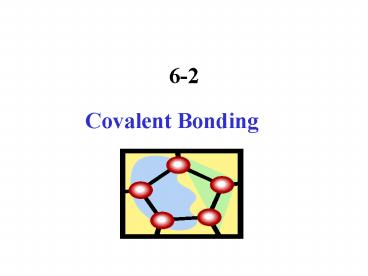Covalent Bonding - PowerPoint PPT Presentation
1 / 26
Title:
Covalent Bonding
Description:
MOLECULAR COMPOUND: a cmpd that is made of molecules. MOLECULAR FORMULA: shows the kinds & #s of ... DIATOMIC MOLECULE: molecule containing only 2 atoms i.e. H2 ... – PowerPoint PPT presentation
Number of Views:169
Avg rating:3.0/5.0
Title: Covalent Bonding
1
6-2
- Covalent Bonding
2
- MOLECULE neutral group of atoms held together by
covalent bonds - MOLECULAR COMPOUND a cmpd that is made of
molecules - MOLECULAR FORMULA shows the kinds s of atoms
making up a molecule i.e. H2O - DIATOMIC MOLECULE molecule containing only 2
atoms i.e. H2
3
Why would nature favor forming a covalent bond?
4
- Attraction nucleus of one atom to the electron
cloud of the other atom - Repulsion both nuclei repelas do both electron
clouds
- As atoms approach, attraction increases and
potential E goes down - Beyond a certain point, repulsion increases and E
goes up
? bottom of valley on E curve is where there is a
balance between attraction and repulsion
5
Characteristics of the Covalent Bond
- Bond Length average distance between 2 bonded
atoms (min potential E)
In the H2 molecule, the 1s orbitals overlap and
result in a increased electron density between
the nuclei.
6
(No Transcript)
7
Bond energy
- Energy required to break a chemical bond and form
neutral isolated atoms - Measured in kJ/mol (kilojoules/mole)
- Positive value
- Bond energy and bond length values will vary
depending on what atoms an element is bonded
toavg. values found on tables P.168)
8
Octet Rule
- Chemical cmpds tend to form so that each atom, by
gaining, losing or sharing electrons, has an
octet (8) of electrons in its highest (outermost)
energy level - Example of exceptions
- H only has 2 valence e-s to reach stability
- B only has 6 valence e-s to reach stability
- Some elements have gt 8 (occurs when atom bonds
with highly electroneg. elements some d e-s
are involved in bonding)
9
Electron Dot Diagrams
- Electron configuration notation in which only the
valence electrons of an atom of a particular
element are shown, indicated by dots placed
around the elements symbol - F 1s22s22p5
10
(No Transcript)
11
other dot diagram format
- Mg Ne3s2
- paired electrons are shown as a pair
12
Lewis Structures
- Formulas in which.
- atomic symbols represent nuclei and inner-shell
electrons - Dot-pairs or dashed between 2 atoms represent
electron pairs in covalent bonds - Dots adjacent to only one atomic symbol represent
unshared electrons
13
(No Transcript)
14
Lewis structure
Structural Formula indicates The kind, number,
arrangement, and bonds..but NOT the
unshared Pairs of the atoms in a molecule
15
Lewis structure
Single bond covalent bond produced by the
sharing on ONE pair of electrons between 2 atoms
16
How do you draw a Lewis Structure? Ex Carbon
Tetrachloride (CCl4)
- 1. Determine the type and number of atoms in the
molecule - One C atom and 4 chlorine atoms
- 2. Write the electron dot notation for each type
of atom in the molecule - C has 4 dots around it (one on each side).
For 4 valence e-s - Each Cl has 7 dots for its 7 valence electrons
17
- 3. determine the total number of valence
electrons in the atoms to be combined. - C 1 x 4 e - 4 electrons
- Cl 4 x 7 e- 28 electrons
- Total 32 electrons
- 4. Arrange the atoms to form a skeleton structure
for the molecule. If C is present, it is the
central atom. Otherwise , the least
electronegative atom is central (except H, it is
never central). Then connect the atoms by
electron-pair bonds. Add unshared electrons.
18
(No Transcript)
19
- 5. count the number of electrons in the structure
to be sure that the number of valence electrons
used equals the number available. Be sure at all
the atoms besides H have an octet.
20
Multiple Covalent Bonds
- DOUBLE BOND
- sharing of TWO pairs of electrons between 2 atoms
- TRIPLE BOND
- sharing of THREE pairs of electrons between 2
atoms - Bond Energies
- triple gt double gt single
- ..triple bonds are stronger and shorter
21
WE will do an example on the board!!!
22
Resonance Structures
- bonding in molecules or ions that cannot be
correctly represented by a single Lewis structure
23
Draw the resonance structure for sulfur trioxide,
SO3
- WE will do this on the board also!!
24
Draw the resonance structure for sulfur trioxide,
SO3
- S 6 e-
- O 3 x 6 e-
- Total 24 e-
25
Covalent-network Bonding
- Covalent bonding exists
- throughout a large network
- of atomswill be
- discussed in chapter 12
- i.e. carbon atoms
- in a diamond
26
HOMEWORK
- Do Section Review on p. 175































